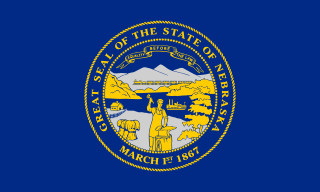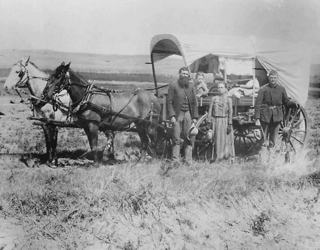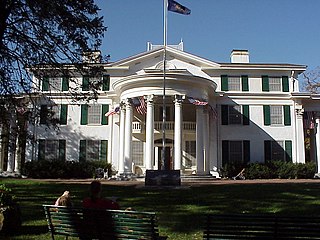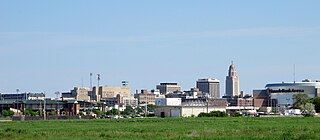
Lincoln is the capital of the U.S. state of Nebraska and the county seat of Lancaster County. The city covers 94.267 square miles (244.150 km2) with a population of 284,736 in 2017. It is the second-most populous city in Nebraska and the 71st-largest in the United States. The city is the economic and cultural anchor of a substantially larger metropolitan area in the southeastern part of the state called the Lincoln Metropolitan and Lincoln-Beatrice Combined Statistical Areas. The statistical area is home to 353,120 people, making it the 106th-largest combined statistical area in the United States.

The First Transcontinental Railroad was a 1,912-mile (3,077 km) continuous railroad line constructed between 1863 and 1869 that connected the existing eastern U.S. rail network at Omaha, Nebraska/Council Bluffs, Iowa with the Pacific coast at the Oakland Long Wharf on San Francisco Bay. The rail line was built by three private companies over public lands provided by extensive US land grants. Construction was financed by both state and US government subsidy bonds as well as by company issued mortgage bonds. The Western Pacific Railroad Company built 132 mi (212 km) of track from Oakland/Alameda to Sacramento, California. The Central Pacific Railroad Company of California (CPRR) constructed 690 mi (1,110 km) eastward from Sacramento to Promontory Summit, Utah Territory. The Union Pacific built 1,085 mi (1,746 km) from the road's eastern terminus at Council Bluffs near Omaha, Nebraska westward to Promontory Summit.
Scouting in Nebraska has a long history, from the 1910s to the present day, serving thousands of youth in programs that suit the environment in which they live.

Fremont is a city in Dodge County in the eastern portion of the state of Nebraska in the Midwestern United States. The population was 26,397 at the 2010 census. Fremont is the county seat and the home of Midland University.

Columbus is a city in and the county seat of Platte County, in the state of Nebraska in the Midwestern United States. The population was 22,111 at the 2010 census.

The Chicago and North Western Transportation Company was a Class I railroad in the Midwestern United States. It was also known as the North Western. The railroad operated more than 5,000 miles (8,000 km) of track as of the turn of the 20th century, and over 12,000 miles (19,000 km) of track in seven states before retrenchment in the late 1970s. Until 1972, when the employees purchased the company, it was named the Chicago and North Western Railway.

The Central Branch Union Pacific Railroad was a railroad in the U.S. state of Kansas. Originally planned as a line from Atchison west into Colorado, and given federal land grants by the Pacific Railway Act of 1862 as one of the branches of the Union Pacific Railroad, it was left with a hanging end at Waterville, Kansas when the Union Pacific Railway, Eastern Division, with which it was to connect, changed its route. The line was acquired by the Union Pacific through a stock purchase by Jay Gould and leased to the Missouri Pacific Railroad in 1880. In 1909 the Central Branch was merged into the Missouri Pacific; the latter company came back into the Union Pacific system in 1982. In 1991 the remaining trackage west of Frankfort was leased to the Kyle Railroad.
The MoPac Trail is a rail trail in Nebraska. It is a bicycling, equestrian, and walking trail built on an abandoned Missouri Pacific Railroad corridor that runs for 26 miles (42 km) from Lincoln, Nebraska, to Wabash, Nebraska.
The Kansas, Oklahoma and Gulf Railway (KO&G) was formed on July 31, 1919 from the assets of the bankrupt Missouri, Oklahoma and Gulf Railway. The KO&G largely consisted of a single line from Baxter Springs, Kansas, to Denison, Texas, prior to its purchase by Missouri Pacific's Texas and Pacific Railway in 1964 and merger in 1970.
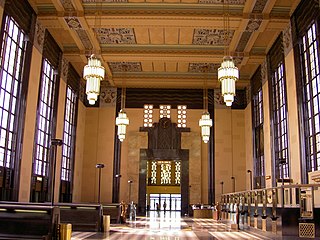
The Union Station, at 801 South 10th Street in Omaha, Nebraska, known also as Union Passenger Terminal, is "one of the finest examples of Art Deco architecture in the Midwest." Designated an Omaha Landmark in 1978, it was listed as "Union Passenger Terminal" on the National Register of Historic Places in 1971, and was designated a National Historic Landmark in 2016. The Union Station is also a contributing property to the Omaha Rail and Commerce Historic District. It was the Union Pacific's first Art Deco railroad station, and the completion of the terminal "firmly established Omaha as an important railroad terminus in the Midwest."

Transportation in Omaha, Nebraska, includes most major modes, such as pedestrian, bicycle, automobile, bus, train and airplane. While early transportation consisted of ferries, stagecoaches, steamboats, street railroads, and railroads, the city's transportation systems have evolved to include the Interstate Highway System, parklike boulevards and a variety of bicycle and pedestrian trails. The historic head of several important emigrant trails and the First Transcontinental Railroad, its center as a national transportation hub earned Omaha the nickname "Gate City of the West" as early as the 1860s.
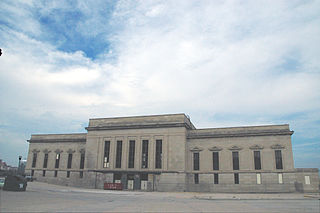
Railroads in Omaha, Nebraska have been integral to the growth and development of the city, the state of Nebraska, the Western United States and the entire United States. The convergence of many railroad forces upon the city was by happenstance and synergy, as none of the Omaha leaders had a comprehensive strategy for bringing railroads to the city.
Credit Foncier of America was a late 19th-century financing and real estate company in Omaha, Nebraska. The company existed primarily to promote the townsites along the Union Pacific Railroad, and was incorporated by a special act of the Nebraska Legislature in 1866. Credit Foncier was said to be "intimately connected with all the early towns along the Union Pacific."

French people have been present in the U.S. state of Nebraska since before it achieved statehood in 1867. The area was originally claimed by France in 1682 as part of La Louisiane, the extent of which was largely defined by the watershed of the Mississippi River and its tributaries. Over the following centuries, explorers of French ethnicity, many of them French-Canadian, trapped, hunted, and established settlements and trading posts across much of the northern Great Plains including the territory that would eventually become Nebraska, even in the period after France formally ceded its North American claims to Spain. During the 19th century, fur trading gave way to settlements and farming across the state, and French colonists and French-American migrants continued to operate businesses and build towns in Nebraska. Many of their descendants continue to live in the state.
The history of Lincoln, Nebraska began with the settlement of the village of Lancaster in 1856. The county of Lancaster was founded in 1859. Prior to settlement from the westward expansion of the United States, Plains Indians, descendants of indigenous peoples who occupied the area for thousands of years lived in and hunted along Salt Creek. Settlers first came to extract salt from the wild salt flats of Salt Creek. Nebraska was granted statehood March 1, 1867. Soon afterwards a commission created by the State was appointed to locate the State Capital on State lands. The village of Lancaster was chosen for the Capital of Nebraska. The village of Lancaster became Lincoln. Lincoln was named after Abraham Lincoln. The first State Capitol was completed in 1868. Lincoln incorporated on April 1, 1869.
The following is a timeline of Lincoln, Nebraska history including significant social, political, cultural, and economic events in the history of Lincoln.
